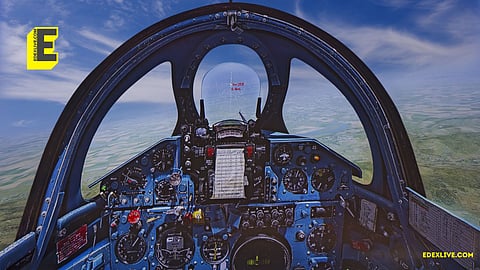
- News
- Campus
- Exam
- Podcast
- Web Stories
- Do You Know
- Path Finders - UG Programs
- Videos
- Élitscape

Aerospace engineering, one of the most sought-after branches of engineering as deals with the design, development, testing, and maintenance of aircraft, spacecraft, launch vehicles, rockets, propulsion systems, engines, airframes, power systems, weapons, navigation, communication, instrumentation and many other related systems and subsystems that are crucial and critical for space missions.
In the recent past, it has gained momentum because of our numerous successful space missions and its versatile commercial utilities across the globe in weather forecasting, disaster management, earth observation, astronomy, telepathy, healthcare, space colonisation, scientific exploration, navigation, military, national security, planetary exploration, forestry, transportation, and many other societal development initiatives.
The main function of aerospace engineers and technicians is to develop state-of-the-art technologies related to airframes, engines, avionics, weapon systems, missile technology, rockets science, navigation systems, control and instrumentation systems, robotics, propulsion, combustion, aerodynamic fluid flow, etc and their integration and maintenance.
Spacecraft and other flying machines have very complex systems and use highly reliable, robust components, systems, and subsystems to withstand extreme temperatures, vibration, gusty winds, and unforeseen and abrupt weather changes during flight missions. Each component used in design has got to be military grade and it goes through accelerated and rigorous weathering tests.
Students who are looking forward to having a career in the aerospace sector will have ample opportunities to get not only a plethora of their dream jobs in prestigious government and defence public sectors like National Aeronautics and Space Administration (NASA), Indian Space Research Organisation (ISRO), Hindustan Aeronautics Limited (HAL), Bharat Dynamics Limited (BDL), Bharat Electronics Limited (BEL), Electronics Corporation of India Limited (ECIL), Defence Research and Development Organisation (DRDO), academic institutions and many other private industries such as Boeing India, Airbus, Rolls-Royce, GE aerospace, Brahmo aerospace, Tata Advanced systems, Lockheed Martin, Thales, Mahindra aerospace, L&T and so on and armed forces within India and abroad.
However, the passion to work tirelessly with innovative minds and achieve the unachievable must get embedded in you to derive the ultimate job satisfaction and fetch worldwide recognition.
In the Indian aerospace sector, the government of India has taken several indigenisation initiatives that give a tremendous boost to the Make in India policy.
Setting up of Defence Industrial Corridors in Uttar Pradesh and Tamil Nadu are brilliant examples, aimed to promote domestic R&D through DRDO. The development of our indigenous aircraft like the Tejas (Light Combat Aircraft, LCA) has been testimony to our self-reliance programme. Thousands of private sector and start-up companies have produced Indigenous aircraft military-grade components.
India has built advanced systems like the INS Vikrant aircraft carrier, drastically reduced the dependence on imports, and fostered the self-reliance initiative in aerospace manufacturing.
There are countless opportunities in the aerospace sector. The career in this sector is extremely exciting, satisfying, rewarding, and challenging. To name a few, aerospace-qualified engineers, aeronautical engineers, electrical, mechanical, electronics, instrumentation, avionics, software, communication, production engineers, and technicians can be engaged in the following prestigious roles in the scientific, military, and civil industries.
However, you must acquire the requisite skill sets and gain the research flavour during the pursuit of your academic excellence. Here are a couple of segments below:
1. Aerospace and aircraft engineer
2. Aeronautical engineer in electronics and mechanical
3. Aerospace technicians and tradesmen
4. Aviation manager
5. Flight technician
6. Flight test engineer
7. Weapon engineers and technicians
8. Aerodynamic engineer
9. Aviation engineer
10. Control and instrumentation engineer
11. Material engineer
12. Manufacturing Engineer
13. Pilot and mission specialists
14. Astronauts
15. Reliability engineer
16. Flight Engineer
17. Flight signaler
18. Flight engineer
19. Gunner
20. Design engineer
21. Maintenance engineer etc
The best institutions to pursue a career in aerospace/aeronautical engineering are the Indian Institute of Technology (IIT) Madras, IIT Kanpur, IIT Kharagpur, IIT Mumbai, IIT Delhi, and many other state and private institutions.
The salary compensation depends purely on your professional acumen, experience, and your personality. As per my experience as an academician at entry level 6 to 12 lakh approximately per annum, at mid-career 12 to 24 lakh approx and at senior level there is no limit, provided you have the passion, professional, leadership attributes, innovative minds, rich experience and unwavering commitment for your employers.
For extraordinary students even at entry level, you can fetch 50 lakh per annum and beyond.
After having served as a commissioned officer, from Pilot Officer to Air Commodore in the Indian Air Force for about three decades and more than one decade in academics as a Vice-Chancellor, I would like to advise all space enthusiasts, budding aerospace and aeronautical engineers and scientists to take a plunge into Aerospace sector and dive deeper to derive ultimate pleasure and great success.
The career in this sector is unparalleled and unmatchable.
(Prof (Dr) Sanjay Kumar VSM (veteran) is the Vice-Chancellor of RV University, Bengaluru. Views expressed are his own.)
